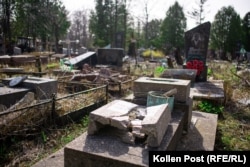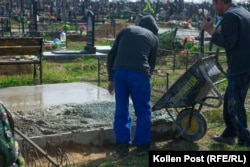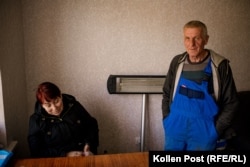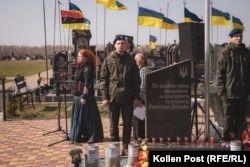CHERNIHIV, Ukraine -- Even in wartime, a cemetery is supposed to be a sanctuary. Not so when the front line runs through the graveyard and Russian tanks rumble over the dead.
"Four strikes hit this place," said Volodymyr Cherdakov, an engraver, gesturing at his exhibition space, where headstones both blank and sketched have fallen over each other like granite dominoes. "Tanks, mortars -- the big guys. And the building caught fire."
Cherdakov is one of the many gravediggers, engravers, and tomb repairers whose workshops cluster around the base of the hill that leads up to Yatseve Cemetery, the largest in Chernihiv.
Signs in their windows advertise "monuments," meaning headstones, many including examples of their work that feature the detailed, lifelike portraits popular in Ukraine, Russia, and some other countries.
For a time, the site was within a kilometer of the Ukrainian post that marked the endpoint of Russia's deadly but ultimately unsuccessful siege of Chernihiv.
"For two months they didn't bury anyone here," said Vova Chekh, a gravedigger, of the weeks that followed Russia's full-scale invasion on February 24, 2022. "Every day, planes bombed at 5 a.m. If I hadn't been drinking, it would have messed me up. Bombing -- let's put it this way: It strikes at your psyche."
Russian tanks passed through the cemetery on the outskirts of Chernihiv, trying to break through Ukraine's defenses as the invading forces laid siege to the city. Authorities reported a fire in the Church of St. Theodosius, which overlooks the sprawling site.
Splatters of shrapnel are still inescapable in the neighborhood next to the cemetery, Novoselivka. The Chekhs have patched up their shop as best they could, the storefront now held together with billows of instant foam.
Natasha Chekh, who runs the shop, recalls fleeing to a village further outside Chernihiv, with too many neighbors stuffed into too few cars. That village, Mazhuhivka, soon fell under Russian occupation.
The Chekhs figured on being out of town for three days and brought a single suitcase. Instead, they ended up sleeping in a cold basement for a month. By day, their neighbors in Mazhuhivka would share and barter food based on stockpiles that nobody had planned to last so long.
The couple remained outside the besieged city until March 22, the feast day of the Holy 40 Martyrs, when they were able to make it back home.
"I think this religious holiday helped," Natasha said, suggesting a higher power had a hand in their good fortune. "We were driving blind."
Into an already crowded car they managed to stuff a man in uniform who was hitchhiking into the city, saying he needed to report for duty. "Either a volunteer or a soldier, we don't know, but he knew the way home through the woods and swamps when all the roads were mined and the bridges were blown," she said.
Tombstone Blues
The Chekhs are not just gravediggers.
"We do it all," Vova said with a grin, a fat blister flaring under a fingernail as he used a long board to level a shimmering new layer of concrete over a double grave. His hands are mottled with Portland cement, which he mixes with a shovel in a red wheelbarrow, giving off a smell like gunpowder. It would be 21 April days, he said, before the new slab is dry enough to add the headstones.
Spring had come to Chernihiv, and across the sprawling cemetery, visitors busily tended to the graves of their loved ones, placing fresh flowers and repainting the fences that surround some of the sites. A woman hacking at a flower bed with a hand rake sobbed quietly under the shelter of her kerchief.
Small shot glasses sit on saucers at the base of many headstones, waiting for visitors to pour the next round. Many of the gravesides have a private bench where family and friends gather for a meal, after which it's considered bad luck to take any leftovers home for later.
Customs stick tightly to death, and cemeteries are, of course, laden with memories. In both Ukrainian and Russian, the equivalent of "rest in peace" literally translates as "eternal memory." At Yatseve, you can see the Russian variant fall out of style rapidly, starting around 2005, and it is gone completely from headstones of the past five years or so.
For Vova and Natasha, theirs is a reverse family business -- one that their son started and that they run, with him now serving at the front.
Not far from where Vova was repairing a grave, a crowd gathered around the Alley of Heroes, an area reserved for soldiers killed fighting against the Russian invasion. Dozens of fresh blue-and-yellow flags whirl over congregants and guards, as well as headstones heavy on end dates in 2022.
The Russian siege of Chernihiv was over by March 31, about five weeks after it began.
People like the Chekhs and Cherdakov would spend the next two years both burying the new dead and replacing the graves damaged during the Russian onslaught. Despite many repairs, a wide swath near the church remains absolutely devastated, with temporary metal crosses stuck behind shattered headstones.
Like other Ukrainian cities, Chernihiv remains in Russia's crosshairs: An aerial attack on April 17 killed at least 18 people, one of the deadliest Russian strikes on civilians this year.
But since the war on the ground moved further away, residents have tried to keep the memory of their fight alive even as they've had to bury their dead.
Chernihiv sits well under 100 kilometers from both Russia and Belarus, and Russian troops poured over both borders when the February 2022 invasion began. They saw the largely Russian-speaking city as a veritable pitstop on the way to Kyiv.
Instead, the Russians met with fierce resistance that turned Chernihiv into one of the key chokepoints that defined the first weeks of the full-scale war and foiled the Kremlin's plans to seize Ukraine's capital and subjugate the country.
Ukrainian forces have not claimed credit for it, but the explosion that blew a key bridge over the Desna River stopped the Russian advance from the south in its tracks and pushed Moscow’s forces into a corridor to the east of Chernihiv. The checkpoint that formed the last barrier of Ukraine's defense still stands on Taras Shevchenko Street a few hundred meters from Cherdakov's shop.
Massive shelling along that street reduced hospitals, homes, and police stations to rubble. And headstone shops as well.
Grave Architecture
Despite occasional attacks, such as the deadly strike near the heart of the city on April 17, Chernihiv is being rebuilt, far beyond the cemetery gates. The Hotel Ukraine still lies in rubble on the central Red Square, but a new bridge stretches over the Desna, planned to reconnect the most direct route to Kyiv sometime in May. And even in Novoselivka, a flock of modular homes paid for by Poland cropped up just south of the checkpoint to house people who have lost their homes.
Across northern Ukraine and in other areas retaken by Ukraine in the first year of the all-out war, the memory of the violence of its initial months is losing its immediacy as the front lines have ossified far away. This puts morale, which was galvanized by the start of the full-scale invasion, on potentially shaky ground.
The words for grave in Russian and Ukrainian are spelled identically but pronounced distinctly: "mogila" or "mohyla." Pro-Russian Internet trolls long ago cobbled the word into a portmanteau with Ukraine's military mobilization efforts, so it is "mogilizatsia" -- "grave-ification." Russia's propaganda machine today is getting plenty of use out of the term in floods of ongoing social media operations to undercut Ukrainian morale.
"Look around. There are no men left. They're either in the war, or they're already lying there," said Vova, nodding at the surrounding graves.
Many in Ukraine are fighting against forgetfulness, particularly as the country is pushing for more Western aid and seeking more recruits. Zelenskiy signed an unpopular mobilization law this week, on the heels of legislation reducing the minimum draft age from 27 to 25.
Cellar Of Death
Traveling south from the bridge being repaired over the Desna leads in fairly short order to Yahidne, a village that bore the great misfortune of sitting at the fork of two major roads.
This is where Russian soldiers held 368 residents in atrocious conditions underground for weeks, after forcing them into the cellar beneath a kindergarten that they commandeered as their local headquarters. The captives were human shields, hostages used to prevent Ukraine from targeting the building.
"There was just no chance for living," said Ivan Polhuy, surveying the dank, dark space where he and the others had been imprisoned. "No sanitation at all."
Two years later, the air underground was damp and foul. Like in a horror movie, children's toys and trinkets were scattered around, along with human filth. Scraps of clothing and dirty boots lay on the floor between the legs of chairs, most missing backs. Cut water bottles hung off of pipes overhead, an effort to catch condensation and leaks from the school’s plumbing.
For some of the captives, the basement became a tomb. Four had died, their bodies decomposing, before the Russians let anyone out to bury them, Polhuy recalls -- out of a total of at least 10 people who did not survive.
The captives sat in the dark with the dead, he says. Hungry children cried continuously. Some people tried to sleep in school chairs. Illness was rampant. Polhuy says he dodged the worst, except for his legs, which suffered from disuse.
Seventeen names are marked off alongside a black chalk calendar of March 2022, suggesting the toll was higher than the official tally of 10.
On March 31, an expression of joy and relief marks the calendar: “Ours have arrived!” – meaning Ukrainian soldiers. Russian troops were withdrawing – part of a massive setback for the invading forces in the north, where they were stopped short of Kyiv and retreated across the border.
Last month, on March 11, a court in Chernihiv convicted 15 Russian soldiers of committing war crimes in Yahidne and sentenced each of them, in absentia, to 12 years in prison.
Making Memories
Chernihiv has a rich history that goes back more than 1,000 years -- and after its successful defense, the Russian invasion is still adding grim new chapters like the attack on April 17.
In February, the Chernihiv Historical Museum announced a project to document the details of the Yahidne ordeal. Running this initiative is Maksym Blakytniy, the director of the museum.
A bespectacled man in a trim blue suit, Blakytniy speaks with a professorial lilt. When asked about his favorite periods of Chernihiv history, he jumps to the ongoing millennium of the Principality of Chernihiv, and some recent finds of artifacts from Norman times.
But for Blakytniy, the museum's project of documenting the siege, and Yahidne in particular, evokes a horror that befell Ukraine less than a century ago: the Holodomor, the manmade famine that killed millions of its citizens in 1932-33, under Soviet dictator Josef Stalin.
"If you compare [this] to the events of the Holodomor," he said, there's a difference in the approach. At that time, the authorities "were not interested in establishing evidence of what happened. Even after World War II...the government remained non-Ukrainian and was more interested in covering up what happened."
Part of Blakytniy's task is putting together evidence solid enough to stand up to what he suggested is an incessant stream of Russian propaganda and false or unsubstantiated claims: "Russia, with history -- with any event, even the small ones -- will turn it into propaganda in their own interests. They'll wash away their own sins and somehow put the blame on Ukraine."
In that challenging context, and with Russia's invasion still raging, people like Blakytniy are working to make sure that the memories of events like the ordeal at Yahidne do not veer from the facts as time passes -- to affix them in the history of Ukraine.
Meanwhile, Yahidne is well on its way to being fully repaired, having received extensive funding both from home and abroad. While a crushed shell of a rusted-out car still lies in a garden, workers have repaired the large living homes and life seems to be returning to normal.
Nobody is going to reopen the kindergarten, though.
"100 percent: There’s not going to be anything like that here anymore," Polhuy said. But he hopes to preserve the space below as-is, as a museum of its own. "So that we remember," he said, "who the Russians are."






